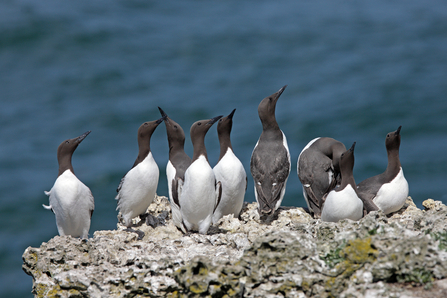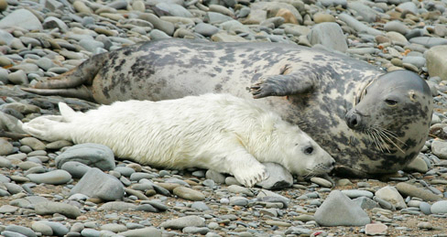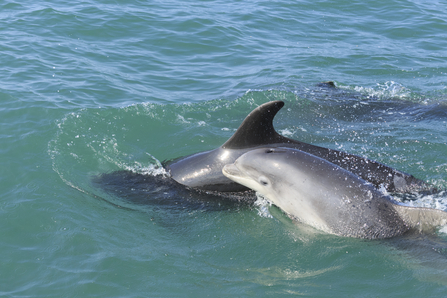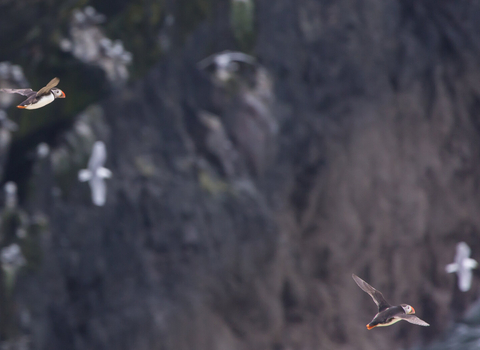Seabirds, seals and cetaceans are fascinating to watch. However, we must be careful not to disturb these animals.

Alan Williams / naturepl.com
Seabirds
Birds leaving their nesting or roosting sites is a common and sad consequence of disturbance. This results in chicks becoming more vulnerable to predation while the adults are away - eggs are not being incubated, hatching is delayed and eggs are knocked off the cliff. In a Site of Special Scientific Interest (SSSI) the disturbance of wildlife is a criminal offence.
Causes of seabird disturbance:
- Proximity to the colony or nest
- Larger groups of people
- Length of time people spend at the site
- Speed of approach and departure
- Noise
How to know if you are disturbing seabirds:
- Birds fly off cliffs – move slowly away, you are already too close
- Agitation such as head craning, head turning, head bobbing, and wing flapping in situ. Do not proceed if you observe this as you will make them fly.
- Listen for alarm calls and increased vocalisation.
How to avoid disturbing seabirds:
- Timing - the beginning of March to the end of July is a particularly sensitive time as birds come ashore to nest.
- Keep a distance of 100m from seabird nesting sites/cliffs whether on the water or on land.
- If you think you are disturbing seabirds move slowly and quietly away.
- Do not approach rafting birds.
- Always move on after 10 minutes of watching.

Janet Baxter
Seals
Seals are sensitive to disturbance and are protected in Britain under the Conservation of Seals Act 1970. The Wildlife and Countryside Act prohibits interference with places used for shelter or protection, or intentionally disturbing animals occupying such places.
Causes of seal disturbance:
- Noise - unnatural sounds, such as voices, boat engines etc
- Sight - seals spook when crafts, such as kayaks and boats. come too close. Human silhouettes on cliff tops and even your shadow cast from above can disturb seals on the beach below. Keep low and move slowly.
- Distance - keep a distance of at least 50m from hauled out and pupping seals.
If you are disturbing seals they will:
- Lift their heads and orientate their heads towards the sea.
- Bulge their eyes revealing the white parts around the iris.
- Moves towards the water - any seal rushing into the sea has been disturbed.
- Show behaviour in the water, such as rapid swimming to and from, sudden panic diving, and re-entry into the water.
At all times watch the seals’ reactions and respect them by acting accordingly. If you spot any of this behaviour move slowly out of sight, you are already too close.
What is the problem?
- Seals that are rushing towards the sea may stampede, scaring others around them into a domino effect.
- Rushing seals are less careful and may gash their bellies or rip out claws on the rocks.
- Seals need to haul out at low tide to heal wounds, gain vitamins from the sun and moult.
- Seal pups need their mother’s milk 4-5 times for the first 18 days after birth. Mothers can be disturbed away from their pups preventing suckling, resulting in underweight pups and in extreme cases pups starving.
How to avoid disturbing seals:
- At all times watch the seals’ reactions and respect them by acting accordingly. If you spot any of this behaviour move slowly out of sight, you are already too close.
- Keep a distance of at least 50m from seal haul-out beaches whether on the water or on land.
- Do not approach rafting marine mammals.
- Do nothing to disturb or frighten the seals or their pups e.g. loud noises and fast movements like running and pointing.
- Do not get between the adult seal and their pup. Adult females often rest in the water just offshore from their pup. Avoid coming between them.
- Always move on after 10 minutes of watching.
- Keep all dogs away, preferably on a lead.
- Do not chase them into the water.

Janet Baxter
Cetaceans
Dolphins, porpoises and whales are sensitive to disturbance and are protected by law.
How to avoid disturbing cetaceans:
- Speed - vessels should slow down to a speed less than 5 knots and avoid erratic changes in speed.
- Continue on a steady course with no sudden or erratic movements.
- Allow groups of cetaceans to remain together and avoid deliberately driving through them.
- Avoid coming between a mother and calf and always allow cetaceans an escape route and avoid boxing them in,
- Do not chase cetaceans.

